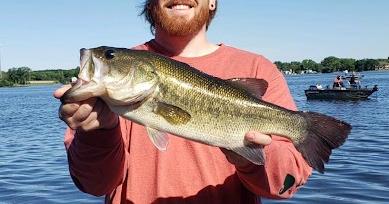This guide explores the seasonal variations in bass habits and the strategic methods essential to ensure the perfect catch. From spring through winter, Devan Bald offers insights into the ideal lures and techniques for each season, equipping fishers with the necessary tools to catch bass. With this valuable data, anglers can make informed judgments to improve their fishing ventures and maximize their chance for success.
Bass Fishing in Every Season
Bass fishing devotees have the opportunity to engage in their hobby year-round. To maximize their chances of a successful catch, anglers must be adaptable, customizing their techniques based on the season and location. During the spring, when bass are engaged in spawning activities, focusing on shallow waters can generate positive outcomes. As the summer brings higher temperatures, transitioning to deeper waters and utilizing crankbaits or topwater lures may be more compelling. The autumn season allows baitfish motions to be replicated, taking advantage of bass’s heightened feeding activity before winter sets in. The art of bass fishing is grounded in the angler’s ability to understand and apply these strategic adaptations throughout the year.
Seasonal Changes in Bass Behavior
Understanding the seasonal changes in bass behavior is essential for successful fishing trips, as these fluctuations are shaped by factors such as water temperature, accessible fishing locations, and the species of bass inhabiting the area.
How Bass Behave in Different Seasons
Bass display various behavioral patterns correlating to seasonal fluctuations responding to temperature changes. In spring, bass often occupy shallow waters close to shorelines, actively searching in anticipation for mating season. Anglers can capitalize on this by utilizing artificial lures that imitate the visual appearance and motions of tiny baitfish or crayfish. As summer progresses, bass relocate to deeper regions for cooler temperatures and shaded environments, such as submerged flora. This transition necessitates adjustments in angling strategies, such as utilizing heavier gear to target these deeper zones effectively.
Approaches for Spring Bass Fishing
The springtime season presents distinctive challenges and opportunities for bass anglers, necessitating specialized tactics, careful lure selection, and strategic approaches.
Best Lures and Techniques
Choosing the perfect lures and angling techniques is crucial for successful bass fishing. An essential aspect of selecting the appropriate lure is understanding the behavior of the bass. For instance, largemouth bass are recognized as aggressive predators; therefore, using bright-colored crankbaits or spinnerbaits can provoke a bite. Conversely, smallmouth bass are typically more selective and may prefer natural-looking lures like soft plastic worms or jigs. Tailoring your bait selection to your target bass species can enhance your likelihood of a catch. Implementing methods such as slow retrieves or erratic motions, can replicate the natural movements of prey, making your lure even more appealing to bass.
Summer Bass Fishing
Fishing for bass in the summer requires strategic adjustments to address the warm water conditions and increased bass activity. Anglers must thoughtfully revise their approach and focus on certain fishing hotspots to achieve the best results.
Adapting to Warm Water and Active Bass
Adjusting techniques for warm waters and lively bass is imperative for successful angling. Fishermen ought to change their methods to account for the heightened levels of activity and prioritize the seasonal variations in behavior. Predators typically seek sheltered, shaded zones during the day’s heat, making early dawn or dusk prime fishing times. When opting for angling locations, anglers should focus on areas with structures like fallen trees, underwater flora, or outcroppings where bass can conceal themselves and ambush their prey.
Fall Bass Fishing
Anglers pursuing bass in the fall season face unique challenges as the fish populate various depths. To thoroughly explore areas, anglers must skillfully blend diverse tactics with strategic location selection. Bass emerges mid-water, which is challenging to tempt but yields fine sport when enticed.
Targeting Shallow and Deep Water Bass
Fall bass angling necessitates adopting approaches for bass in shallow waters to maximize opportunities and explore deeper waters. Anglers must skillfully utilize pliable techniques and prepare to adapt to shifting behaviors in response to seasonal changes. Throughout the fall season, bass actively search for food before winter’s onset, leading them to frequent shallower areas where they can readily ambush prey. A profound understanding of bass behavior during this period is crucial for successfully situating and enticing them to strike. In deeper water habitats, bass gravitate towards structures or drop-offs, seeking shelter.
Winter Bass Fishing
Winter bassing challenges even seasoned anglers, as temperature constraints slow the fish. Success requires specialized strategies and pinpointed targeting that focuses on bass through the season. Some hide within sun-warmed pockets, while others stake out oxygen-rich areas. With perseverance and an arsenal matched carefully to each situation, resourceful anglers can still find rewarding winter action.
Dealing with Cold Water and Sluggish Bass
Successfully navigating winter bass brings challenges due to frigid waters and inactivity. Anglers must utilize specialized strategies, prime locations, and flexibility. Selecting spots entails deeper waters to conserve energy. Adjusting techniques and targeting structures significantly enhance bites and bass outings.
Key Takeaways and Final Tips
Mastering seasonal tactics and techniques in bass fishing requires strategic skill, fish pattern adaptations, and equipment comprehension to ensure a pleasant experience. Success in understanding behavior habits and demonstrating the ability to customize techniques seasonally is essential.

